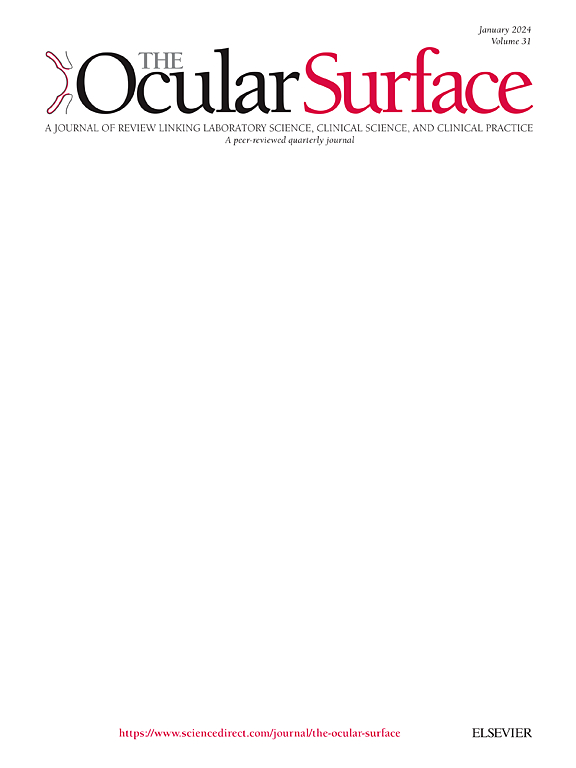利用转基因小鼠模型在体内监测硫芥暴露后角膜病变
IF 5.6
1区 医学
Q1 OPHTHALMOLOGY
引用次数: 0
摘要
目的硫芥(SM)致眼损伤的动态过程包括急性期,可发展为慢性期或静息期,随后是晚期病理。在体内观察角膜病理变化可以加深对这一过程的理解,并有助于治疗的发展。方法采用蒸汽暴露法,在VE-Cadherin启动子(血管和造血细胞)下表达RFP,在角蛋白15启动子(角膜干细胞)下表达GFP,在hy-1启动子(中基质神经纤维,MSNFs)下表达YFP的三种转基因小鼠右眼诱导ssm烧伤。通过体视显微镜观察细胞浸润、新生血管形成(NV)、神经支配丧失和干细胞(SC)耗竭长达8周。角膜全支架用于评估360°结构、浸润细胞和基底下神经丛(SNP)损失。组织学包括H&;E,马松-三色,周期性酸-希夫染色。结果sa - 35-s暴露引起轻度眼损伤,伴有中度SNP改变、角膜细胞浸润和可逆性SC丢失,大部分在4周内消退。暴露120 s可引起NV的严重损伤,广泛的MSNF和SNP丢失,明显的CD45+和Iba1+浸润,以及不可逆的SC消耗。组织学上可见NV、间质炎症、水肿、上皮改变和杯状细胞,并与荧光成像相关。结论转基因小鼠可作为研究sm致眼损伤的有效模型,并可用于开发新的治疗策略。本文章由计算机程序翻译,如有差异,请以英文原文为准。
Use of a transgenic mouse model for in vivo monitoring of corneal pathologies following Sulfur Mustard Exposure
Purpose
The dynamic course of sulfur mustard (SM)-induced ocular insult involves an acute phase, which may progress to a chronic phase or a quiescent period, followed by late pathology. Visualizing pathological corneal changes in vivo could enhance understanding of this process and aid treatment development.
Methods
SM burn was induced in the right eyes of three transgenic mouse strains—expressing RFP under the VE-Cadherin promoter (blood vessels and hematopoietic cells), GFP under the keratin 15 promoter (limbal stem cells), and YFP under the Thy-1 promoter (mid-stromal nerve fibers, MSNFs)—by vapor exposure. Cell infiltration, neovascularization (NV), innervation loss, and stem cell (SC) depletion were monitored in vivo by stereomicroscopy for up to 8 weeks. Corneal whole-mounts were used to assess 360° structures, infiltrating cells, and subbasal nerve plexus (SNP) loss. Histology included H&E, Masson-Trichrome, and periodic acid-Schiff staining.
Results
A 35-s exposure caused minor ocular insult with moderate SNP changes, corneal cell infiltration, and reversible SC loss, mostly resolving by 4 weeks. A 120-s exposure caused severe insult with NV, extensive MSNF and SNP loss, marked CD45+ and Iba1+ infiltration, and irreversible SC depletion. NV, stromal inflammation, edema, epithelial changes, and goblet cells were seen in histology and correlated with fluorescence imaging.
Conclusions
This study demonstrates the utility of transgenic mice as powerful models for studying SM-induced ocular injury and for developing novel therapeutic strategies.
求助全文
通过发布文献求助,成功后即可免费获取论文全文。
去求助
来源期刊

Ocular Surface
医学-眼科学
CiteScore
11.60
自引率
14.10%
发文量
97
审稿时长
39 days
期刊介绍:
The Ocular Surface, a quarterly, a peer-reviewed journal, is an authoritative resource that integrates and interprets major findings in diverse fields related to the ocular surface, including ophthalmology, optometry, genetics, molecular biology, pharmacology, immunology, infectious disease, and epidemiology. Its critical review articles cover the most current knowledge on medical and surgical management of ocular surface pathology, new understandings of ocular surface physiology, the meaning of recent discoveries on how the ocular surface responds to injury and disease, and updates on drug and device development. The journal also publishes select original research reports and articles describing cutting-edge techniques and technology in the field.
Benefits to authors
We also provide many author benefits, such as free PDFs, a liberal copyright policy, special discounts on Elsevier publications and much more. Please click here for more information on our author services.
Please see our Guide for Authors for information on article submission. If you require any further information or help, please visit our Support Center
 求助内容:
求助内容: 应助结果提醒方式:
应助结果提醒方式:


